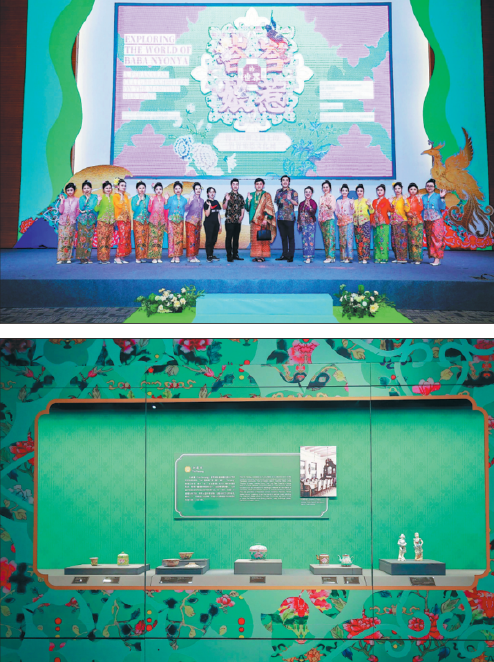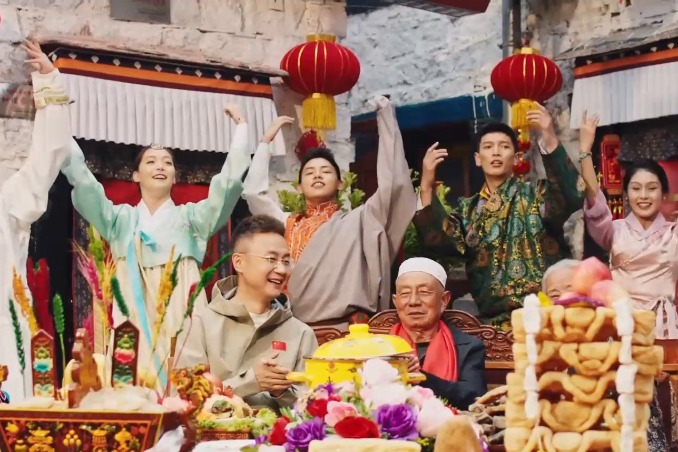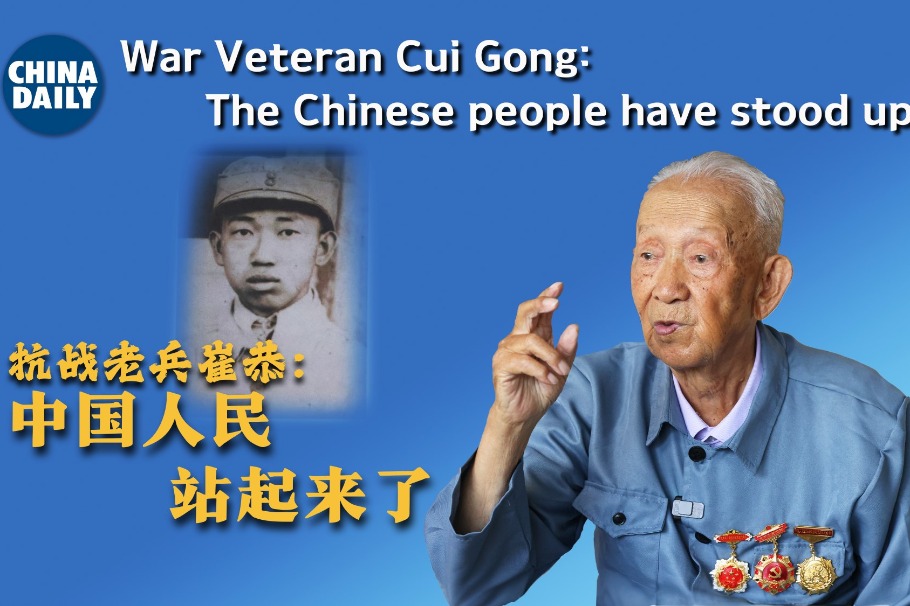Exhibition highlights maritime cultural fusion
Visitors step into the Baba Nyonya world on display in Hainan, exploring the rich history of its heritage, Chen Bowen reports in Haikou.

A silver engraved cigarette case from Singapore is on display in Qionghai, South China's Hainan province, where it serves as a poignant reminder of Lim Boon Keng's enduring legacy and the lasting friendships and goodwill that transcend borders and time.
Manufactured in 1925 by the London firm Henry Perkins & Sons, the cigarette case is inscribed with the heartfelt message: "Presented to Dr. Lim Boon Keng, Xiamen University, in tribute to his friends and well-wishers — Singapore, February 25, 1926."
Lim, a prominent Peranakan activist in the early 20th century, was not only a champion of educational reform but also a bridge between Southeast Asian Peranakans and their cultural roots in China.
In 1921, Lim took on the role of the second president of Xiamen University in China, a position he held until 1937. He was dedicated to fostering cultural and philanthropic ties between Singapore and China, which was endorsed by his friends and well-wishers who presented him with the sterling cigarette case.
Thanks to the generosity of his grandson Lim Kok Lian, this treasured cigarette case is now one of the exhibits of the Exploring the World of Baba Nyonya exhibition. Showcasing the Maritime Silk Road and Peranakan culture, it is being held at the China (Hainan) Museum of The South China Sea from March 26 to June 26.
The Peranakan, also known as the Baba (male) and Nyonya (female), are mixed-race descendants of immigrants from the Ming Dynasty (1368-1644) of China who intermarried with indigenous Southeast Asians. This unique community is a vibrant blend of Chinese and Malay cultures, resulting in a rich and distinctive Baba Nyonya heritage.
Han Junyuan, a Malaysian-Chinese descendant living in Hainan, visited the exhibition in late March. "I've heard of Lim Boon Keng's legacy as an exceptional Straits Chinese. It was a special moment for me to finally see his related item showcased in the exhibition," he says.
The exhibition has curated a collection of 124 pieces and sets of cultural relics from the Asian Civilisations Museum and the Peranakan Museum in Singapore, along with 13 pieces of Peranakan furniture from the China (Hainan) Museum of The South China Sea.
Drawing on cultural relics and historical materials, the exhibition balances both popularity and professionalism to showcase the important cultural elements from a variety of perspectives. From Peranakan portraits to traditional clothing, household items, wedding customs and architectural styles, the exhibition offers a comprehensive view of the vibrant and intricate Baba Nyonya world.
Clothing and accessories stand as the hallmark cultural representatives of the Baba Nyonya culture. They serve as a bridge between the past and present, blending traditional aesthetics with contemporary styles to create a unique sartorial expression.
One of the most iconic examples of Baba Nyonya fashion is the traditional attire of the Nyonya, known as the Kebaya. This traditional blouse-dress encapsulates the rich cultural heritage of the community, featuring intricate embroidery, vibrant colors and delicate patterns that tell stories of tradition and craftsmanship. The Kebaya not only preserves traditional cultural elements but also evolves with the times, inspiring contemporary fashion trends in Singapore, Malaysia and Indonesia, notes WeChat public account Museum Headlines.
Beyond clothing, accessories play a vital role in enhancing the beauty and storytelling of Baba Nyonya fashion. Intricately beaded shoes, ornate jewelry and delicate hair ornaments are just a few examples of the accessories that adorn Baba Nyonya garments, adding an extra layer of detail and symbolism to the overall look.
The food culture of the Baba Nyonya community is a testament to the intricate fusion of Chinese traditions and local influences. Their dishes often incorporate auspicious elements drawn from Chinese culture in the hope of bringing luck, prosperity and good fortune to the dining table.
The architecture of the Baba Nyonya community also reflects the unique fusion of Chinese and Malaysian traditions.
In the exhibition area, visitors are greeted with a palette of colors that include white, red and green, each carrying its own significance and cultural heritage. White and red are prominent colors in traditional Chinese Hokkien architecture, symbolizing purity, prosperity and good fortune. Green, on the other hand, is considered an auspicious color in Malaysian culture, representing growth, harmony and balance.
By incorporating these colors into the exhibition space, visitors can connect with the themes of Baba Nyonya culture and deepen their immersion in the world being showcased.
Through the vibrant hues and diverse color palette of Baba Nyonya architecture, visitors are invited to appreciate the diversity and harmonious blend of traditions that define the community's unique identity, according to Museum Headlines.
Xin Lixue, director of the China (Hainan) Museum of The South China Sea, says that the exhibition serves as a bridge for deepening cultural exchanges and fostering mutual understanding between China and Southeast Asia.
"Through the exploration of cultural relics and artifacts, visitors are transported back in time to envision the bustling scene of maritime trade routes, witness the rich legacy of Peranakan traditions and appreciate the harmonious integration of Chinese, Singaporean and Malaysian cultural influences," Xin says.
Clement Onn, deputy director of Curatorial and Research of the Asian Civilisations Museum in Singapore, highlights the Peranakan's deep-rooted connections to both Chinese traditions and the diverse local communities of Southeast Asia.
"They have not only preserved the customs and practices of their Chinese ancestors but also actively engaged with and assimilated into the multicultural fabric of the regions where they settled, resulting in a vibrant fusion of cultures that is uniquely their own," Onn says.
Onn hopes that through this exhibition, audiences will gain a better understanding of the Baba Nyonya culture, which will also serve as a catalyst for promoting cultural awareness and cross-cultural appreciation among Chinese audiences.
"By showcasing the integrated cultures of Singapore and other countries in Southeast Asia, the exhibition aims to foster a spirit of curiosity, dialogue and exchange, encouraging audiences to embrace the diversity and richness of Southeast Asian heritage," he says.
Liu Yuzhu, head of the China Foundation for Cultural Heritage Conservation, underscores the significance of the Baba Nyonya culture as a testament to the vibrant fusion of Chinese and Southeast Asian influences along the ancient Maritime Silk Road.
"The Peranakan culture is celebrated for its uniqueness, richness and colorful tapestry. It stands as a living embodiment of the enduring people-to-people connections and friendships that have flourished among the diverse peoples of Asian countries over the centuries," Liu says.
Han, the visitor, says that witnessing the intricate details of the traditional costumes, the relics' exquisite craftsmanship and the stories captured in old photos was truly a profound experience.
"By providing a platform for showcasing the cultural heritage of the Baba Nyonya community, the ongoing exhibition serves as a means for dialogue, understanding and appreciation of the interconnectedness of cultures," Han adds.


Today's Top News
- Israel's Gaza takeover plan widely condemned
- S. Korea visa waiver spurs surge in travel interest
- Top cities signal easing to support property market
- Ties bolster heritage protection
- Gaza 'takeover' will ignite another horrific chapter for the Middle East: China Daily editorial
- STAR shines for innovative companies






























